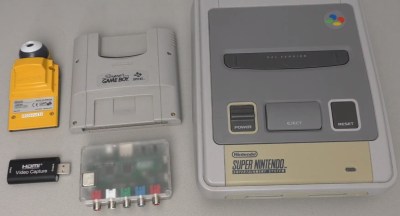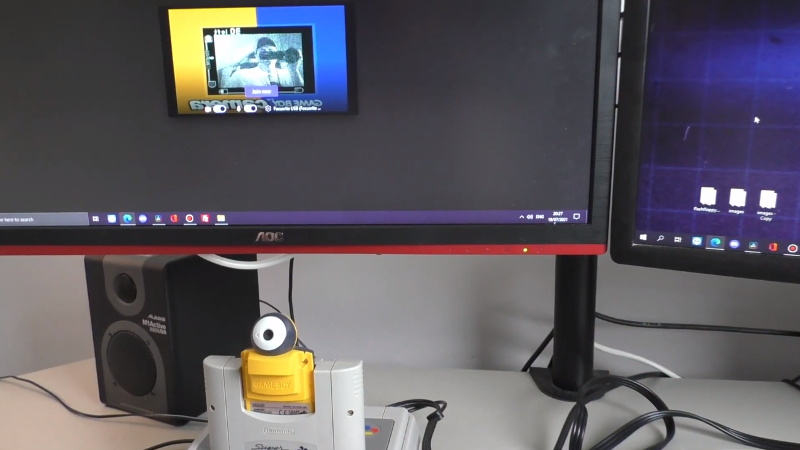We can’t promise it will all be positive, but there’s no question you’ll be getting plenty of attention when you join a video call using the Game Boy Camera. Assuming they recognize you, anyway. The resolution and video quality of the 1998 toy certainly hasn’t aged very well, and that’s before it gets compressed and sent over the Internet.
 From a technical standpoint, this one is actually pretty simple, if rather convoluted. [RetroGameCouch] hasn’t modified the Game Boy Camera in any way, he’s just connected it to the Super Game Boy, which in turn is slotted into a Super Nintendo. From there the video output of the SNES is passed through an HDMI converter, and finally terminates in a cheap HDMI capture device. His particular SNES has been modified with component video, but on the stock hardware you’ll have to be content with composite.
From a technical standpoint, this one is actually pretty simple, if rather convoluted. [RetroGameCouch] hasn’t modified the Game Boy Camera in any way, he’s just connected it to the Super Game Boy, which in turn is slotted into a Super Nintendo. From there the video output of the SNES is passed through an HDMI converter, and finally terminates in a cheap HDMI capture device. His particular SNES has been modified with component video, but on the stock hardware you’ll have to be content with composite.
The end result of all these adapters and cables is that the live feed from the Game Boy Camera, complete with the Super Game Boy’s on-screen border, is available on the computer as a standard USB video device that can be used with whatever program you wish. If you’re more interested in recovering still images, we’ve recently seen a project that lets you pull images from the Game Boy Camera over WiFi.















I actually have all the hardware needed but never though of using it this way (to troll my colleagues); nice hack!
Me too. It would be interesting for streaming SNES game play live too.
That’s easy enough with this setup. The Retrotink2x is a ‘zero-lag’ upscaler, which makes it useful for live gameplay.
And if you come up with a way to use controllers over ip you could play games on original hardware over the net.
Great video. Short and sweet.
I looked for information on connecting the game boy camera to my computer many years ago. While the game boy can access the camera sensor, I believe you can get even better results accessing the camera with modern hardware. You should be able to find the data sheet about the sensor, and it even has real time effects like edge detection. You might be able to get a higher frame rate as well. I remember a project where the person used red, green, and blue films to expose the sensor to the same shot, then layered the results for a ‘full’ color image.
Perhaps https://github.com/AntonioND/gbcam-rev-engineer is useful?
Personally, I fear the horrible dithering is important to the aesthetic, otherwise it’s “just” a 128×128 greyscale sensor.
Nah, the dithering isn’t that bad if you’re using the RF out of the Super Nintendo.
Just connect it to some vintage frame grabber/TV receiver card for the ISA bus (Hauppauge WinTV etc) that you’ve installed in your Windows 3.1/9x rig. :)
No kidding! Did this in the late 90s/early 90s myself. Worked like a charm.
These old cards had quality receivers, from what I can tell.
My card also had a Videotext decoder built-in, so I could read the news on my VGA monitor.
Now that I’m thinking of it, Windows 98SE or Me could perhaps be new enough for today’s video conferencing software.
There’s the KernelEx project, which allows Win 9x to run some Windows XP/Vista era programs to run..
The only problem is some of your call members may not even know what “Game Boy” is.
If they’re younger than the last Gameboy they’re under 17 so that’s probably not the audience for this kind of gimmick anyway.
If they know of Pokémon, Tetris or Wario/Super Mario games, they surely had heard of the Gameboy before at some point.
That being said, many kids today show an interest for the stuff their parents or older siblings played with in their youth. :)
In addition, video game history is a thing on YouTube.. Kids into video gaming will surely stumble over one or two retro episodes by accident, anyway.
Sadly not the worst quality video I’ve been subjected to on a zoom call.
I know the menus and border have colour, but there’s still something hilarious about using component video what is essentially a black and white (not even grayscale) video feed. Well Done.